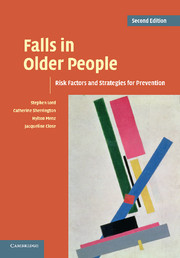Book contents
- Frontmatter
- Contents
- Preface
- Acknowledgements
- Part I Epidemiology and risk factors for falls
- Part II Strategies for prevention
- 10 Exercise interventions to prevent falls
- 11 Exercise interventions to improve physical functioning
- 12 Medical management of older people at risk of falls
- 13 Assistive devices and falls prevention
- 14 Modifying the environment to prevent falls
- 15 Prevention of falls in hospitals and residential aged care facilities
- 16 A physiological profile approach to falls risk assessment and prevention
- 17 Research into practice
- Part III Research issues in falls prevention
- Index
- References
12 - Medical management of older people at risk of falls
Published online by Cambridge University Press: 03 May 2010
- Frontmatter
- Contents
- Preface
- Acknowledgements
- Part I Epidemiology and risk factors for falls
- Part II Strategies for prevention
- 10 Exercise interventions to prevent falls
- 11 Exercise interventions to improve physical functioning
- 12 Medical management of older people at risk of falls
- 13 Assistive devices and falls prevention
- 14 Modifying the environment to prevent falls
- 15 Prevention of falls in hospitals and residential aged care facilities
- 16 A physiological profile approach to falls risk assessment and prevention
- 17 Research into practice
- Part III Research issues in falls prevention
- Index
- References
Summary
Older people present to a wide range of healthcare specialists with problems related to or causing falls. The role of individual professions and institutions in the assessment and management of the older faller is not always apparent with frequent blurring of professional and organizational boundaries.
Only one-quarter of falls amongst community-dwelling older people are reported to any healthcare professional, but of those who do report a fall, 75 % do so to their general practitioner (GP). It is therefore imperative to ensure that GPs are aware of existing evidence-based assessment tools and intervention strategies, and have available to them appropriate referral pathways to allow for more detailed assessment and intervention if required.
This chapter discusses the role of the medical practitioner in the identification and management of the older person at risk of falling. It focuses on assessments and interventions that are traditionally within the skill set of a doctor, but also acknowledges that as professional boundaries and areas of specialization change, others may undertake some of the assessments and interventions covered.
Identification of at risk populations
Identification of at risk populations is key to the delivery of effective interventions to prevent falls in older people. At present there is limited evidence to support a population-based approach to falls prevention. It is interesting to note that such interventions have developed in parallel with the individual randomized controlled trials and have not in all cases used known evidence-based approaches to prevention.
- Type
- Chapter
- Information
- Falls in Older PeopleRisk Factors and Strategies for Prevention, pp. 240 - 263Publisher: Cambridge University PressPrint publication year: 2007
References
- 1
- Cited by



